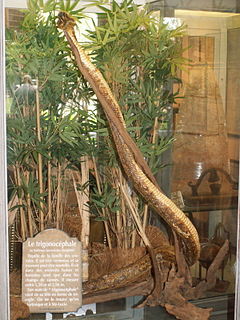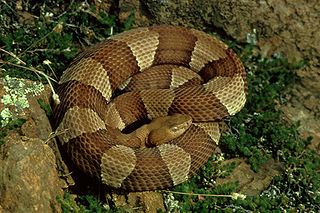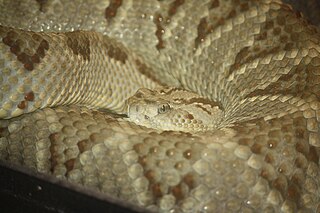
Agkistrodon piscivorus is a species of pit viper in the subfamily Crotalinae of the family Viperidae. It is the world's only semiaquatic viper, and is native to the southeastern United States. As an adult, it is large and capable of delivering a painful and potentially fatal bite. When threatened, it may respond by coiling its body and displaying its fangs. Individuals may bite when feeling threatened or being handled in any way. It occurs in or near water, particularly in slow-moving and shallow lakes, streams, and marshes. It is a capable swimmer and, like several species of snakes, is known to occasionally enter bays and estuaries and swim between barrier islands and the mainland.

Agkistrodon is a genus of pit vipers commonly known as American moccasins. The genus is endemic to North America, ranging from the Southern United States to northern Costa Rica. Eight species are currently recognized, all of them monotypic and closely related. Like all pit vipers, members of the genus are venomous. Common names include: cottonmouths, copperheads, and cantils.

Bothrops lanceolatus — known as the fer-de-lance, Martinican pit viper, and Martinique lancehead — is a species of pit viper generally considered endemic to the Caribbean island of Martinique. Some reserve the common name fer-de-lance for this species, while others apply that name to other Bothrops species as well. No subspecies are currently recognized.

Terciopelo is a species of pit viper occurring at low to moderate elevations in northeast Mexico and Central America, and into South America where it is known from elevations up to 2600 meters in the Colombian and Ecuadorian Andes, as well as Venezuela and Trinidad on the Caribbean coast. With a mass up to 6 kilograms (13 lb) and the maximal length of 2.5 metres (8.2 ft), terciopelo is among the largest pit vipers. It is light to dark brown in color, often with yellow zig-zag-shaped line on each side of the body. Dubbed "the ultimate pit-viper" for its large size, fangs and venom yield, it has a fearsome reputation, responsible for the most snakebites within its range because of its defensive temperament and proximity to human residence. However, in common with other venomous snakes it avoids confrontation with humans whenever possible. No subspecies are currently recognized.

The western cottonmouth was once classified as a subspecies of the cottonmouth. However, DNA based studies published in 2008 and 2015, revealed no significant genetic difference between the eastern cottonmouth and the western cottonmouth and synonymized the two subspecies. The resulting taxonomy does not recognizes the western cottonmouth as a valid taxon. Several subsequent reviews and species accounts have followed and supported the revised taxonomy. Information on this snake can be found in the Agkistrodon piscivorus article.

Agkistrodon taylori is species of venomous snake, a pitviper (Crotalinae) found only in northeastern Mexico. The standardized names are Taylor's cantil (English) and Metapil (Spanish), although it is sometimes called the ornate cantil as well as several other colloquial names. It was named in honor of American herpetologist Edward Harrison Taylor.

The Florida cottonmouth is a species of venomous snake, a pitviper in the subfamily Crotalinae of the family Viperidae. The species is endemic to the United States, where it occurs in southern Georgia and the Florida peninsula in nearly every type of wetlands in the region, including brackish water and offshore islands. However, it is not entirely dependent on water and is occasionally encountered as far as a mile from surface water. Agkistrodon conanti venom is very hemolytic and known to cause relatively extensive necrosis compared to many snake venoms, and can sometimes be lethal with a 17% mortality rate. It is often confused with harmless watersnakes (Nerodia) and other semi-aquatic species with which it shares its habitat.

Agkistrodon laticinctus is a venomous pit viper species, formerly considered a subspecies of Agkistrodon contortrix, which is found in the southern United States, from Kansas, through Oklahoma and throughout central Texas.

Crotalus simus is a venomous pit viper species found in Mexico and Central America. The specific epithet is Latin for "flat-nosed", likely because its head is blunt compared with lanceheads (Bothrops). Three subspecies are recognized, including the nominate subspecies described here.

Agkistrodon contortrix mokasen was formerly a venomous pit viper subspecies found in the eastern United States. However, recent taxonomic changes do not recognize the northern copperhead as a valid taxon.
Atropoides picadoi, also known as Picado's jumping pitviper, is a species of venomous snake, a pitviper in the subfamily Crotalinae of the family Viperidae. The species is endemic to Central America. There are no subspecies that are recognised as being valid. It is monotypic in the genus Atropoides.
Bothriechis marchi is a species of pitviper, a venomous snake in the subfamily Crotalinae of the family Viperidae. The species is endemic to Central America. There are no subspecies that are recognized as being valid.

Cerrophidion tzotzilorum is a venomous pit viper species which is native to southern Mexico. There are no subspecies that are recognized as being valid.

Porthidium hespere is a venomous pitviper species found in western Mexico. No subspecies are currently recognized.

Porthidium nasutum is a venomous pitviper species found in southern Mexico, Central America and northern South America. No subspecies are currently recognized.

Bothrops bilineatus, also known as the two-striped forest-pitviper, parrotsnake, Amazonian palm viper, or green jararaca, is a highly venomous species of pit viper found in the Amazon region of South America. Two subspecies are currently recognized, including the nominate subspecies described here. A pale green arboreal species that may reach 1 m (3.3 ft) in length, it is an important cause of snakebite throughout the entire Amazon region.
Agkistrodon howardgloydi is a species of venomous snake, a pit viper (Crotalinae), that is endemic to Central America. It is most commonly called castellana,but it has also been called the southern cantil, Gloyd's moccasin, and a number of other colloquial names. It is a rare species with a relatively small geographic distribution in the tropical dry forest on the Pacific coast of Honduras, Nicaragua, and extreme northwest Costa Rica. Agkistrodon howardgloydi is a stout, medium sized snake with a maximum length of 96 cm. It is a viviparous species, with female giving birth in the rainy season from May to August. No clinical reports on envenomation had been published, but laboratory texts and analysis indicate the venom is highly toxic and similar to its close relative Agkistrodon bilineatus, and potentially lethal.
Agkistrodon russeolus, commonly called the Yucatecan cantil, is a venomous pit viper species endemic to the Yucatán Peninsula in Mexico and northern Belize.

Bothrops oligolepis is a venomous pitviper species found in Peru and Bolivia. The specific name is derived from the Greek words oligo and lepis, meaning "few scales"; probably an allusion to the lower numbers of dorsal and ventral scales that it has compared to B. bilineatus. No subspecies are currently recognized.

Snakebite envenomation is considered a public health problem in Latin America, with an estimated 70,000 cases annually, but due to underreporting, these numbers may be even higher.


















